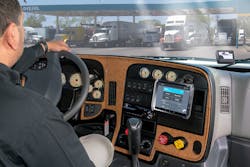The Federal Motor Carrier Safety Administration (FMCSA) compiles data in seven BASICs (Behavior Analysis and Safety Improvement Categories) to calculate a fleet’s overall CSA (Compliance, Safety and Accountability) score. The seven BASICs are:
- Unsafe Diving
- Hours of Service Compliance
- Driver Fitness
- Controlled Substances & Alcohol
- Vehicle Maintenance
- Hazardous Materials Compliance
- Crash Indicator
It pays to do well on your BASICs because you will likely qualify for electronic bypass systems, like PrePass, and save time and money by not having to stop at weigh stations. More important, you will be measurably safer – and safety is everyone’s goal.
Let’s look at the second BASIC, Hours of Service Compliance, and specifically Electronic Logging Devices (ELDs). Citations may be issued for failure to use ELDs, or failure to use them properly, and FMCSA is counting those violations against a motor carrier’s CSA score. Here’s practical advice on working with ELDs to improve your Hours of Service Compliance BASIC:
- Be properly equipped. FMCSA reports that only 1% of trucks currently checked do not have an ELD. But if you are among the 1%, or if you are new to trucking, visit the FMCSA website at for a list of registered ELD vendors.
- Be fully equipped. The ELD mandate also requires that trucks carry an “ELD information packet” containing:
- A user’s manual detailing how to operate the ELD;
- An instruction sheet describing the data transfer mechanisms supported by the ELD being used, and step-by-step instructions to transfer the driver’s hours-of-service records to a safety official;
- An instruction sheet with ELD malfunction reporting requirements and recordkeeping procedures; and
- A supply of blank driver’s records of duty status (RODS) graph-grids to record the driver’s duty status and related information for a minimum of 8 days.
Items 1, 2 and 3 can be in electronic form.
- Train your drivers. Drivers should know how to operate their specific ELD and how to transfer HOS data to an enforcement official. If your operation uses rental or leased power units, be sure drivers know how to operate those ELDs, too.
- Watch out for common ELD pitfalls. Drivers must remember to log as off-duty when done for the day… or else post-trip maintenance time may be attributed to the driver’s HOS. In a slip-seat or relay operation, failure to log off-duty may result in time attributed to the wrong driver. Logging off-duty is similarly important before using the truck for “personal conveyance,” such as when driving it to a local restaurant or nearby parking. (Be sure drivers understand how to place their specific ELD into the “personal conveyance” mode after logging off-duty.)
- Know how to edit your ELD entries. Correct your ELD record when, for example, you logged as “off-duty” when you should have entered “on-duty, not driving.” Only the driver and the carrier’s authorized staff can make edits. To be accepted as the official ELD record, any edit must be certified by the driver, who must resubmit the records. Edits must be annotated, explaining the change. Original entries are retained in the ELD for comparison. That means there is an audit trail; do not use edits to cover up HOS violations – a costly falsification of your HOS record that would go against your safety score. Correct honest mistakes before enforcement points out errors.
- Work with your shippers and consignees. “Knowledge is power.” You have exact knowledge, via the ELD, as to when your truck arrived at and left the dock. Leverage that knowledge to minimize shipper delay and detention. Emphasize that you truly want to meet transit time demands… legally. When customers understand their role in HOS compliance, you can dispatch and drive, confident that your business side will not conflict with your legal side.
About the Author
Steve Vaughn
Senior Vice President of Field Operations
Steve Vaughn is senior vice president of field operations at PrePass Safety Alliance, the provider of PrePass weigh station bypass and electronic toll-payment and management services. Vaughn served nearly three decades with the California Highway Patrol and is a past president of the Commercial Vehicle Safety Alliance.
